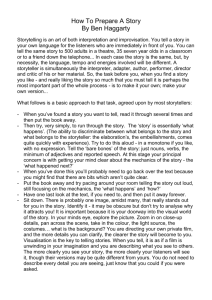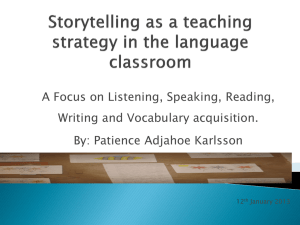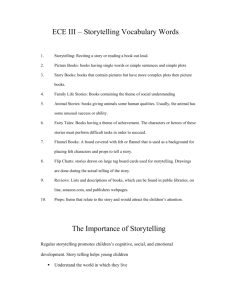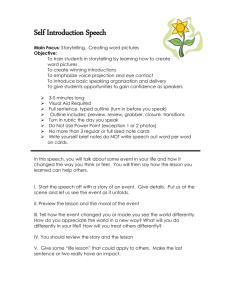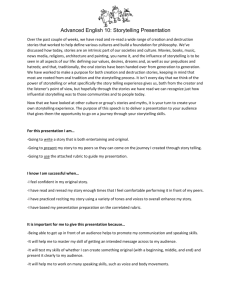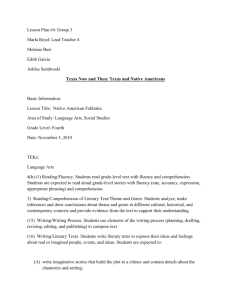surulinathi 28
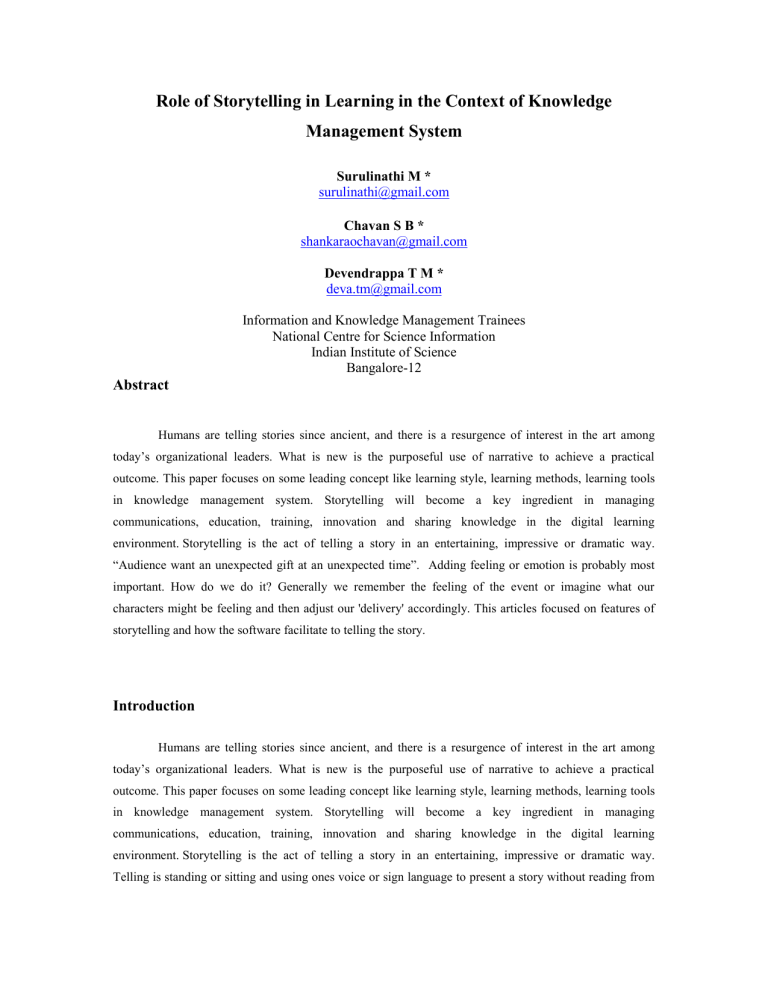
Role of Storytelling in Learning in the Context of Knowledge
Management System
Surulinathi M * surulinathi@gmail.com
Chavan S B * shankaraochavan@gmail.com
Devendrappa T M * deva.tm@gmail.com
Information and Knowledge Management Trainees
National Centre for Science Information
Indian Institute of Science
Bangalore-12
Abstract
Humans are telling stories since ancient, and there is a resurgence of interest in the art among today’s organizational leaders. What is new is the purposeful use of narrative to achieve a practical outcome. This paper focuses on some leading concept like learning style, learning methods, learning tools in knowledge management system. Storytelling will become a key ingredient in managing communications, education, training, innovation and sharing knowledge in the digital learning environment.
Storytelling is the act of telling a story in an entertaining, impressive or dramatic way.
“Audience want an unexpected gift at an unexpected time”. Adding feeling or emotion is probably most important. How do we do it? Generally we remember the feeling of the event or imagine what our characters might be feeling and then adjust our 'delivery' accordingly. This articles focused on features of storytelling and how the software facilitate to telling the story.
Introduction
Humans are telling stories since ancient, and there is a resurgence of interest in the art among today’s organizational leaders. What is new is the purposeful use of narrative to achieve a practical outcome. This paper focuses on some leading concept like learning style, learning methods, learning tools in knowledge management system. Storytelling will become a key ingredient in managing communications, education, training, innovation and sharing knowledge in the digital learning environment.
Storytelling is the act of telling a story in an entertaining, impressive or dramatic way.
Telling is standing or sitting and using ones voice or sign language to present a story without reading from
a book. We're all born storytellers and naturally use storytelling in one shape or other everyday - talking to neighbours, sharing secrets or gossip, recalling something dramatic, exciting or traumatic from our day.
Storytelling
Storytelling is quite simply the use of stories in organizations as a communication tool to share knowledge. Storytelling uses a range of techniques to engage, involve and inspire people, using language that is more authentic (everyday language as opposed to ‘textbook buzzword speak’) and a narrative form that people find interesting and fun. It means ‘Storytelling is telling a story’ and educating and/or entertaining
Storytelling is a process, a medium for sharing, interpreting, offering the content and meaning of a story to an audience.
What can stories be used for?
Storytelling for communications
Storytelling to capture tacit knowledge
Storytelling to embody and transfer knowledge
Storytelling for individual growth
New or unexpected situations
Situations that require feelings as well as thoughts
Complex situations
Categories of stories in organizations
Stories about other people
Stories about the work itself
Stories about the organization
Stories as social bonding
Stories as signals
Stories about the past
Stories about the future
Stories about life itself
Is storytelling an interactive performance art form?
Direct interaction between the teller and audience is an essential element of the storytelling experience. An audience responds to the teller's words and actions. The teller uses this generally non-verbal feedback to immediately, spontaneously, and improvisational adjust the tones, wording, and pace of the story to better meet the needs of the audience.
How do we adjust our delivery?
Tone Of Voice
Loudness
Rhythm
Facial Expression
Body Language
Movement
Hand gestures
Choice of words
The great thing about the ancient, oral tradition of storytelling is that the storyteller gets to change the words. Stories are constantly shaped and reshaped depending on the audience, the circumstances etc.
Some tellers are very careful about their choice of words and some just let it flow naturally. Some follow old traditions, learning the story word for word, gesture for gesture, keeping the story 'pure'. Some change the words and the story line freely, adapting the story to fit the audience and the circumstance.
Style
We can create our own style or copy from someone else's but our storytelling style will be a particular combination of all of the above. We all have a unique style of storytelling and usually a number of styles that we can draw on depending on the circumstances or venue. We might use one style while telling a tall story in a pub with the blokes, another during morning tea at an organisational meeting with a client.
What do audiences want?
All audiences want to able to:
Hear, follow and understand a story
Enjoy putting their imagination to work
Have fun or experience some other strong feelings
Some audiences want to
puzzle over what a story is about
enjoy a good metaphor or other creative word plays
be empowered
be reminded of their goodness
have their beliefs acknowledged and confirmed
feel like they belong
enjoy watching ‘an artist’ at ‘work’
As you develop your skills you can decide to work on adding more of the above.
Learning Styles
Learning styles are simply different approaches or ways of learning.
Types of learning styles
Visual Learners: learn through seeing ...
Auditory Learners: learn through listening...
Tactile/Kinesthetic Learners: learn through , moving, doing and touching...
Storytelling Software
MemoryMiner
PHP-Nuke is a Web Portal System, storytelling software
Comixware
Microsoft Photo Story 3
Windows Movie Maker
Goldwave
MemoryMiner
Import images (simply by dragging and dropping from a folder or photo organizer)
Create of a list of relevant people and locations
Connect people and locations to images
Add descriptions to images
Attach other digital media to images
Select images for export (other relevant media will be automatically selected)
Export your photo-data package to a server of your choice (including .Mac)
View your digital story online
Benefits of Storytelling
Stories are memorable - their messages tend to ‘stick’ and they get passed on. It can provide a ‘living, breathing’ example of how to do something and why it works rather than telling people what to do, hence people are more open to their lessons. Stories therefore often lead to direct action - they can help to close the ‘knowing-doing gap’ (the difference between knowing how to do something and actually doing it).
Communicate quickly
Communicate naturally
Communicate clearly
Communicate truthfully
Communicate collaboratively
Communicate persuasively
Communicate accurately
Communicate entertainingly
Communicate movingly
Communicate feelingly
Communicate interactively
Communicate intuitively
Conclusion
“Audience want an unexpected gift at an unexpected time”. Adding feeling or emotion is probably most important. How do we do it? Generally we remember the feeling of the event or imagine what our characters might be feeling and then adjust our 'delivery' accordingly.
Reference
http://www.storytell.com.au/artnsintro.html
http://www.creatingthe21stcentury.org/Intro6-benefits-story.html
http://www.creatingthe21stcentury.org/Larry-I-overview.html
http://www.memoryminer.com/
http://www.topshareware.com/Comixware-transfer-17533.htm
Author Profile
Surulinathi M
I have completed MLIS., M.Phil from Annamalai University, Chidambaram (Tamilnadu) and have cleared UGC-NET Exam in 2005 December. I have published more than 30 papers in various National and International Conferences and doing Information and Knowledge
Management Training programme at NCSI in Indian Institute of Science, Bangalore-12.
Devendrappa T M
I have completed MSc in library and Information Science from Kuvempu University, Shimoga
(Karnataka). Pursuing Information Knowledge Management Training at NCSI, IISc, Bangalore-
12.
Mr. Chavan S. B.
MLISc from Karnataka University, Dharwad (Karnataka) and UGC-JRF in Dec, 2004. Presently pursuing Information and Knowledge Management Training at NCSI, IISc, Bangalore-12.

